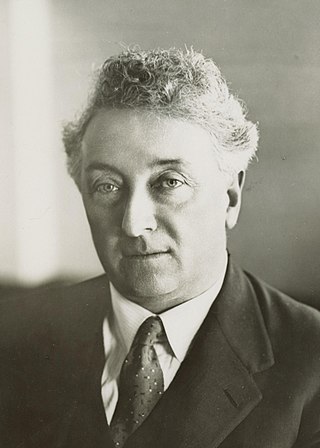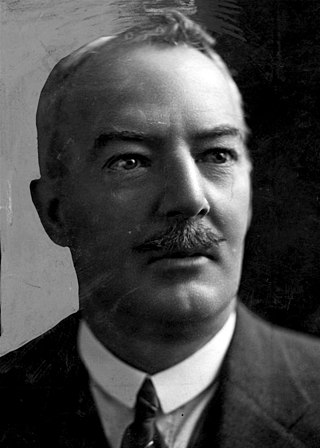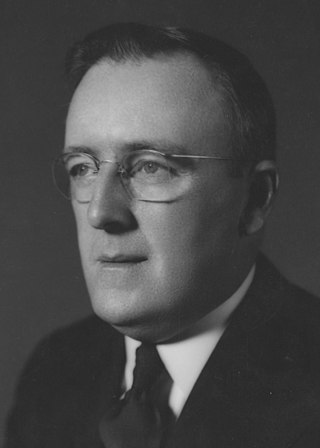
The United Australia Party (UAP) was an Australian political party that was founded in 1931 and dissolved in 1945. The party won four federal elections in that time, usually governing in coalition with the Country Party. It provided two prime ministers: Joseph Lyons (1932–1939) and Robert Menzies (1939–1941).

Joseph Aloysius Lyons was an Australian politician who served as the tenth prime minister of Australia, from 1932 until his death in 1939. He held office as the inaugural leader of the United Australia Party (UAP), having previously led the Tasmanian branch of the Australian Labor Party (ALP) before the Australian Labor Party split of 1931. He served as the 26th premier of Tasmania from 1923 to 1928.

Francis Michael Forde was an Australian politician who served as the 15th prime minister of Australia from 6 to 13 July 1945, in a caretaker capacity following the death of John Curtin. He was deputy leader of the Australian Labor Party (ALP) from 1932 to 1946 and is the shortest-serving prime minister in Australia's history.

James Henry Scullin was an Australian politician and trade unionist who served as the ninth prime minister of Australia from 1929 to 1932. He held office as the leader of the Australian Labor Party (ALP), having briefly served as treasurer of Australia during his time in office from 1930 to 1931. His time in office was primarily categorised by the Wall Street Crash of 1929 which transpired just two days after his swearing in, thus heralding the beginning of the Great Depression in Australia. Scullin remained a leading figure in the Labor movement throughout his lifetime, and was an éminence grise in various capacities for the party until his retirement from federal parliament in 1949. He was the first Catholic, as well as the first Irish-Australian, to serve as prime minister.

Edward John Ward was an Australian politician who represented the Australian Labor Party (ALP) in federal parliament for over 30 years. He was the member for East Sydney for all but six and a half weeks from 1931 until his death in 1963. He served as a minister in the Curtin and Chifley governments from 1941 to 1949, and was also known for his role in the ALP split of 1931.

Edward James "Jack" Holloway was an Australian politician who served in the House of Representatives from 1929 to 1951, representing the Labor Party. He served as a government minister under James Scullin, John Curtin, Frank Forde, and Ben Chifley.

John Chambers Eldridge, Australian politician. He was a member of the Australian House of Representatives from 1929 to 1931, representing the electorate of Martin for the Australian Labor Party (1929–1931) and the splinter Lang Labor party (1931).

Australia was affected badly during the period of the Great Depression of the 1930s. The Depression began with the Wall Street crash of 1929 and rapidly spread worldwide. As in other nations, Australia had years of high unemployment, poverty, low profits, deflation, plunging incomes, and lost opportunities for economic growth and personal advancement.

Lang Labor was a faction of the Australian Labor Party (ALP) consisting of the supporters of Jack Lang, who served two terms as Premier of New South Wales and was the party's state leader from 1923 to 1939. It controlled the New South Wales branch of the ALP throughout most of the 1920s and 1930s. The faction broke away to form separate parliamentary parties on several occasions and stood competing candidates against the ALP in state and federal elections.

John Albert Beasley was an Australian politician who was a member of the House of Representatives from 1928 to 1946. He served in the Australian War Cabinet from 1941 to 1946, and was a government minister in the Curtin and Chifley governments. Beasley was a member of the Australian Labor Party, although on two occasions he left the party to join the breakaway Lang Labor groups, leading the faction in federal parliament. He concluded his career as High Commissioner to the United Kingdom from 1946 until his death in 1949.

James Edward Fenton was an Australian politician. He is notable for having been appointed a cabinet minister by two governments of different political complexions, but resigning from both governments on matters of principle. His first resignation looms largely in history as that came with his political defection, whereas there was no defection with his second resignation.

The 1931 Australian federal election was held on 19 December 1931. All 75 seats in the House of Representatives and 18 of the 36 seats in the Senate were up for election.
This is a list of members of the Australian Senate from 1929 to 1932. Half of its members were elected at the 14 November 1925 election and had terms starting on 1 July 1926 and finishing on 30 June 1932; the other half were elected at the 17 November 1928 election and had terms starting on 1 July 1929 and finishing on 30 June 1935. The process for filling casual vacancies was complex. While senators were elected for a six-year term, people appointed to a casual vacancy only held office until the earlier of the next election for the House of Representatives or the Senate.

The New South Wales Labor Party, officially known as the Australian Labor Party and commonly referred to simply as NSW Labor, is the New South Wales branch of the Australian Labor Party (ALP). The branch is the current ruling party in the state of New South Wales and is led by Chris Minns, who has served concurrently as premier of New South Wales since 2023.

The Lyons government was the federal executive government of Australia led by Prime Minister Joseph Lyons. It was made up of members of the United Australia Party in the Australian Parliament from January 1932 until the death of Joseph Lyons in 1939. Lyons negotiated a coalition with the Country Party after the 1934 Australian federal election. The Lyons government stewarded Australia's recovery from the Great Depression and established the Australian Broadcasting Corporation.

The Premiers' Plan was a deflationary economic policy agreed by a meeting of the Premiers of the Australian states in June 1931 to combat the Great Depression in Australia that sparked the 1931 Labor split.
The history of the Australian Labor Party has its origins in the Labour parties founded in the 1890s in the Australian colonies prior to federation. Labor tradition ascribes the founding of Queensland Labour to a meeting of striking pastoral workers under a ghost gum tree in Barcaldine, Queensland in 1891. The Balmain, New South Wales branch of the party claims to be the oldest in Australia. Labour as a parliamentary party dates from 1891 in New South Wales and South Australia, 1893 in Queensland, and later in the other colonies.

The Australian Labor Party split of 1931 was caused by severe divisions within the Australian Labor Party (ALP) over its economic response to the Great Depression. Amidst intense disagreement between economically conservative and radical elements of the party, two senior ministers in the Scullin Labor government, Joseph Lyons and James Fenton, resigned from Cabinet in January 1931. Lyons, Fenton and their supporters would subsequently merge with the conservative opposition Nationalist Party to form the new United Australia Party (UAP), led by Lyons with the last Nationalist leader, John Latham, as his deputy.

The Australian Labor Party held a leadership election on 1 October 1935, following the resignation of James Scullin. John Curtin was elected as his replacement, defeating Frank Forde and Norman Makin, and consequently became Leader of the Opposition.
The Federal Labor Party were the members of the Australian Labor Party in the state of New South Wales who supported the federal party leadership in the split with the state Labor party which broke away in 1931. Federal Labor retained some seats in the Parliament of Australia but was a minor party in state elections. The dispute was healed in 1936.

















